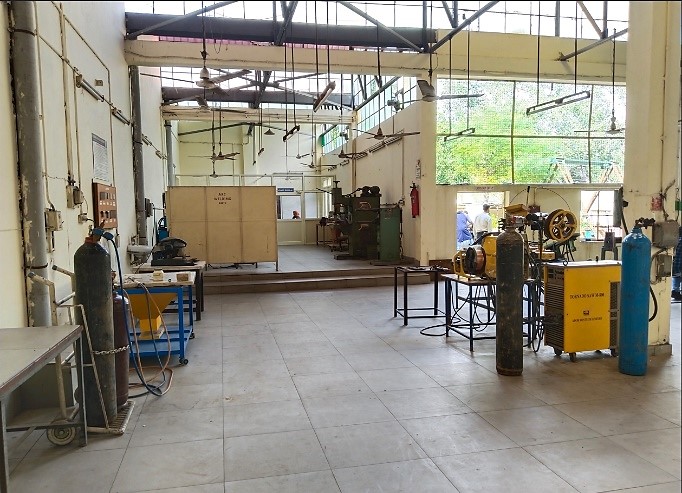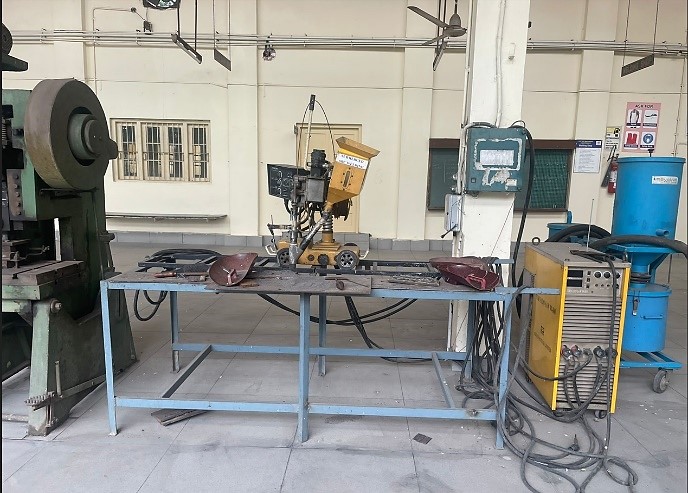

STAFF:
List of Machinery:
|
Make/ No. of Machines |
ADOR India/1 |
|
Model |
Tornado Saw-800 (with Flux recovery unit) |
|
Title of the related experiment: |
Welding of thick sections using fused flux (Granular) |
|
A brief explanation of the usage of the said equipment |
The submerged arc welding machine is a versatile arc welding machine that performs groove or fillet welds in the down-hand position. The submerged arc welding machine has an automatic wire feeding mechanism, flux feeder and recovery unit, and a trolley for automatic welding speed. The device can operate on constant current (CC) and constant voltage (CV) modes. DC power source, which is also known as a self-regulatory arc system. With this setup, students should be able to: · The setting of welding parameters/Understand the effect of welding variables like current, voltage and travel speed according to the workpiece thickness. · Preheating of fused flux to avoid porosity. · Control of heat input by regulating the welding speed of the trolley system. · Evaluate the performance of the system through experiments. · Learn about the applications and limitations of the process. |
2.Gas Tungsten Arc Welding (GTAW) Machine
|
Make/ No. of Machines |
TECHNO WELD India/1 |
|
Model |
MDX-300 |
|
Title of the related experiment: |
Welding of thin sheets of mild steel and stainless steel |
|
A brief explanation of the usage of the said equipment |
The Gas Tungsten Arc Welding machine consists of a rectifier with an HFHV unit and a gun-torch arrangement with an inert gas supply used under a controlled flow rate. The process is also popular for its low heat input. Therefore, it is used for joining thin sheets with or without filler rods. Inert gas is provided to protect the molten material from atmospheric oxidation. An electrode of Tungsten which is non-consumable is used to generate the welding arc. With this setup, students should be able to: · Set welding current and voltage according to the workpiece thickness. · Application and selection of inert gas or gas mixture as per requirement and process economy for shielding purposes. · Evaluate the system's performance through experiments carried out at different voltage and current settings. |
3.Gas Metal Arc Welding (GMAW) Machine
|
Make/ No. of Machines |
ADOR India/1 |
|
Model |
Fontech Tornado MIG 400 |
|
Title of the related experiment: |
Arc welding process using automatic wire feeding system with inert gas shielding |
|
A brief explanation of the usage of the said equipment |
The Gas Metal Arc Welding machine consists of a rectifier, wire feeding mechanism and gun-torch arrangement with an inert gas supply under controlled pressure/flow rate. The machine uses a rectifier to convert AC into DC power and utilizes it at low voltage and high current. The process is equally applicable for thin and thick cross-sections to be welded. Inert gas is provided to protect the molten material from atmospheric oxidation. Automatic wire feeding is provided through a hand-held welding torch gun. Capable of feeding wires of three different diameters 0.8 mm, 1 mm, and 1.2 mm. With this setup, students should be able to: · The welding current and arc voltage are set according to the workpiece dimensions, especially thickness. · The selection of shielding gas, i.e., inert or active gas, for shielding purposes depends on the job material. · Evaluate the system's performance through experiments carried out at different voltage and current settings. · Generally, GMAW is performed in CV mode.
|
4.Gas Metal Arc Welding (GMAW) Machine
|
Make/ No. of Machines |
ADOR India/1 |
|
Model |
Tornado MIG 350 |
|
Title of the related experiment: |
Arc welding process using automatic wire feeding system with inert gas shielding |
|
A brief explanation of the usage of the said equipment |
The Metal Inert Gas Arc Welding machine consists of a rectifier, wire feeding mechanism and gun-torch arrangement with an inert gas supply under controlled pressure/flow rate. The machine uses a rectifier to convert AC into DC power and utilizes it at low voltage and high current. The process is equally applicable for thin and thick cross-sections to be welded. Inert gas is provided to protect the molten material from atmospheric oxidation. Automatic wire feeding is supplied through a hand-held welding torch gun. Capable of feeding wires of three different diameters 0.8mm, 1mm, and 1.2mm. With this setup, students should be able to: · The welding current and arc voltage are set according to the workpiece dimensions, especially thickness. · The selection of shielding gas, i.e., inert or active gas, for shielding purposes depends on the job material. · Evaluate the system's performance through experiments carried out at different voltage and current settings. · Generally, GMAW is performed in CV mode.
|
5.Gas Tungsten Arc Welding (GTAW) Machine - AC/DC
|
Make |
ADOR FONTECH |
|
Model |
TORNADO TIG 315 AC/DC |
|
Title of the related experiment: |
GTAW/TIG welding of Aluminium and stainless-steel sheets/plates |
|
A brief explanation of the usage of the said equipment |
The Gas Tungsten Arc Welding machine is multifunctional: AC Square wave TIG, DC Pulse TIG, DC TIG, MMA and Spot TIG welding machine. Parameters in the panel are set by coordinate type touch key, and all parameters under the five welding states can be stored in the memory channel. This machine can be used for welding Aluminium, stainless steel, and mild steel thin sheets with or without a filler rod. Inert gas is provided to protect the molten material from atmospheric oxidation. An electrode of Tungsten which is non-consumable, is used to generate the welding arc. With this setup, students should be able to: · The variable parameters like current, voltage, arc force, and gas flow rate are according to the workpiece thickness. · Selection of inert gas/gas mixture as per requirement and process application. · Evaluate the system's performance through experiments carried out at different voltage and current settings. · How the pulse TIG could be performed using a square sine wave. |
6.Shielded Metal Arc Welding Machine
|
Make |
ADOR India |
|
Model |
Tornado 401i |
|
A brief explanation of the usage of the said equipment |
The Shielding Metal Arc Welding machine consists of a transformer and electrode holder. Consumable electrodes are flux coated which serves the purpose of shielding. The process is versatile as it allows to change of the electrode material anytime during the operation. However, productivity is not comparable to other arc welding processes. It is a manual arc welding process where electrode feeding and welding speed depend on the operator's skill. With this setup, students should be able to: · Vary the welding current and voltage according to the diameter of the electrode. · The selection of electrode material depends on the job material. · Evaluate the system's performance through experiments carried out at different voltage and current settings. |
7.Resistance Spot Welder
|
Make |
ADVANI OERLIKON |
|
Model |
SP-15/48 |
|
Title of the related experiment: |
Resistance spot welding of thin sheets |
|
A brief explanation of the usage of the said equipment |
The spot welder is a resistance welding machine that is one of the oldest welding processes whereby two or more metal sheets are welded together without using any filler material. The process involves applying pressure by spring expansion which generates a force of 200 KGF and heat to the weld area using shaped alloy copper electrodes which convey an electrical current through the weld pieces. The material comes at the plastic stage, fusing the mating parts; after a few seconds, the current is turned off, pressure from the electrodes is maintained, and the "nugget" solidifies to form the joint. The equation can express this heat: Q = I2Rt In this equation, "Q" is heat energy, "I" is current, "R" is electrical resistance and "t" is the time for which the current is applied. With this setup, students should be able to: · The setting of welding time and according to the workpiece thickness · Understand the resistance heat generation process. · Why cooling of the electrode is necessary. · Evaluate the performance of the process through experiments. · Learn about the process's applications.
|
8.Resistance Seam Welder
|
Make |
MASTER |
|
Model |
MSW – 50 |
|
Title of the related experiment: |
Seam welding of thin sheets of stainless steel/Mild steel |
|
A brief explanation of the usage of the said equipment |
A resistance seam welder is a welding machine whereby two or more metal sheets are welded together without using any filler material. Resistance seam welding can be used to make gas- or fluid-tight joints in various sheet metal fabrications. Steel fuel tanks for motor vehicles are a prime example. The process involves applying pressure by spring expansion and heat to the weld area using shaped alloy copper wheels (act as an electrode) which convey an electrical current through the weld pieces. The material comes at the plastic stage, fusing the parts, and a continuous seam solidifies to form the joint. The equation can express this heat: Q = I2Rt In this equation, "Q" is heat energy, "I" is current, "R" is electrical resistance and "t" is the time for which the current is applied. With this setup, students should be able to: · Setting of current and pressure according to the workpiece thickness · Understand the resistance heat generation process. · Evaluate the performance of the process through experiments. · Learn about the process's applications and limitations necessary for selecting electrode material according to the material to be welded.
|
9.Flash Butt Welding
|
Make |
MASTER |
|
Model |
MFBW - 50 |
|
Title of the related experiment: |
Seam welding of thin sheets of stainless steel/Mild steel |
|
A brief explanation of the usage of the said equipment |
The Flash Butt welder is a resistance welding machine whereby two rods or pipes can be welded together without using any filler material. Flash butt welding is one of the resistance welding processes in which the energy transfer to the parts that will be joined is mainly provided by resistance heat in the parts themselves. Workpieces are positioned end-to-end. As a general rule, the flash butt welding process is subdivided into pre-flashing, preheating, flashing and upsetting. Pre-flashing is used to handle problems when the two surfaces to be joined are not parallel. Preheating is carried out under low welding pressure. This heat can be expressed by the equation: Q = I2Rt In this equation, "Q" is heat energy, "I" is current, "R" is electrical resistance and "t" is the time for which the current is applied. With this setup, students should be able to: · Setting of current and pressure according to the workpiece thickness · Understand the resistance heat generation process. · Evaluate the performance of the process through experiments. · Learn about the process applications and limitations necessary for selecting electrode material according to the material to be welded.
|